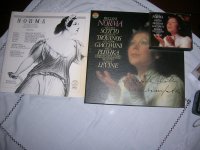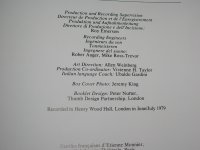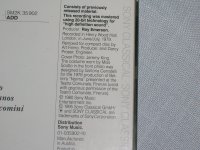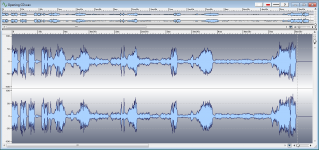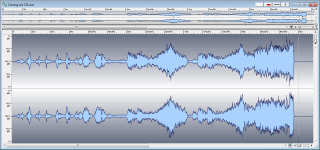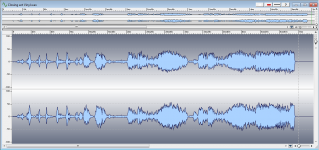And I have tried to give it away for free, only to be put down by the 'hear no difference fraternity' that came to reside in THIS thread. Why this thread? You know why.
When you put your name and your fame to promote products of others in this thread and those products are questionable at best in terms of functionality, you should have considered that some should object.
It’s not wise of you to call them in derogative terms because of that.
George
Of course, the blind listening tests say they sound the same anyway...".
He didn't say ABX did he?
Zung! It is good to hear from you, it has been 33 years. You should give me your info with a private message. We have a lot of catching up to do.
Look guys, I have to put up with a lot of criticism AND name calling on this thread. I can 'suck it up' better than many other designers who have been my friends, so I am still here, and they have gone quiet, because they didn't want to put up with the continuous criticism that they receive when they try to put out a new idea.
Speaking of someone who left this thread, long ago is JAM! Jam has been working as a circuit designer for Pass Labs for some time now. He has matured into a successful designer. See what can happen if you have good 'ears' and are willing to learn how to design SOTA audio circuitry?
Another successful guy is Thorsten, remember him? He is a full time designer with IFI, and resides in China doing what he loves. Both of these guys started here, but were 'kicked off' at some point. I just 'muddle' on. '-)
Look guys, I have to put up with a lot of criticism AND name calling on this thread. I can 'suck it up' better than many other designers who have been my friends, so I am still here, and they have gone quiet, because they didn't want to put up with the continuous criticism that they receive when they try to put out a new idea.
Speaking of someone who left this thread, long ago is JAM! Jam has been working as a circuit designer for Pass Labs for some time now. He has matured into a successful designer. See what can happen if you have good 'ears' and are willing to learn how to design SOTA audio circuitry?
Another successful guy is Thorsten, remember him? He is a full time designer with IFI, and resides in China doing what he loves. Both of these guys started here, but were 'kicked off' at some point. I just 'muddle' on. '-)
Guys,
JC has heralded a bunch of landmark designs and continues to do so through to and including most recent world ultimate awards.
John has experience of and design influence in pretty much every aspect of audio development back to the beginnings of popular music recording, amplification and reproduction through to the present.
Respect is the order of the day, sensible elders are our teachers let us not forget or disregard our forebears.
JC, I understand your process and progression and properly admire/respect your results and standing, you have indeed made a nice difference to the audio world as it stands.
Collectively 'we' have achieved pretty 'good' sound at the present, next gen sound is imminent and is required.
Next gen sound is exactly that and is just around the corner. 😎.
Dan.
JC has heralded a bunch of landmark designs and continues to do so through to and including most recent world ultimate awards.
John has experience of and design influence in pretty much every aspect of audio development back to the beginnings of popular music recording, amplification and reproduction through to the present.
Respect is the order of the day, sensible elders are our teachers let us not forget or disregard our forebears.
JC, I understand your process and progression and properly admire/respect your results and standing, you have indeed made a nice difference to the audio world as it stands.
Collectively 'we' have achieved pretty 'good' sound at the present, next gen sound is imminent and is required.
Next gen sound is exactly that and is just around the corner. 😎.
Dan.
Last edited:
He didn't say ABX did he?
No he didn't. I don't think he cares, neither do I.
Agreed again; surprisingly i was strongly attacked in another forum by the admin after mentioning this positive effect of listening over a longer time span. His point was that i failed to provide scientific evidence for this temporal averaging effect that surely must exist only in my imagination....
Ok This intrigues me. Mark is convinced that his fast switching protocol is higher sensitivity than others for him, and I have no reason to dispute that, just the applicability of this to listening. If we have 2 extremes of approach then that is something worth wasting electrons on to discuss in more depth surely?
Different meanings of long and short in my understanding. Namely, long term meaning running tests over multiple days in order to average out some effects. Like, say having eaten within the last hour or not getting enough sleep the night before. Difficult to characterize, but real concerns for minimizing internal variance.
The actual test protocol is a different story, whether your sample length is a second, minute or millisecond.
It's to say that (let's use ABX for simplicity) one scored 6/10 for 5 consecutive runs. It's much more telling if that's over multiple days than in a single session.
The actual test protocol is a different story, whether your sample length is a second, minute or millisecond.
It's to say that (let's use ABX for simplicity) one scored 6/10 for 5 consecutive runs. It's much more telling if that's over multiple days than in a single session.
I'd say: Short term - is there a difference? Long term - which do I prefer?
A change is as good as a rest.....so
A change is as good as a rest.....so
Last edited:
and will be able to compare and contrast the decca restoration of the Bloch string quartets with the Dutton re-releases
Bill, any news on this?
I do fear it will start me hunting the originals.
A similar case. 🙂
Dropbox - Opening CD.wav
Dropbox - Opening Vinyl 90min TT warm-up.wav
Dropbox - Closing act CD.wav
Dropbox - Closing act Vinyl.wav
George
Attachments
6/10 over 5 consecutive blocks is 30/50. 30/50 is far away from guessing, even though it hits a .06 probability of random chance. (Not that magic p < .05 that is readily manipulable and deservedly losing its importance)
Edit: I was deliberate in choosing 6/10, as a single 6/10 doesn't say much of anything.
Edit: I was deliberate in choosing 6/10, as a single 6/10 doesn't say much of anything.
Last edited:
Ok This intrigues me. Mark is convinced that his fast switching protocol is higher sensitivity than others for him
Not exactly. It depends, both methods can be effective. If sitting down for some kind of blind test, then the ability to switch quickly and effortlessly (without looking if you don't want to) can be very helpful.
On the other hand, when I replaced the old DAC-1 with DAC-3, at that point I could hear the sound of both quite plainly. Now I am so used to DAC-3, I don't notice its sound any more. Some people call that effect 'burn in' but what I think it really is, is accommodation in brain DSP to the sound. It becomes normalized.
Daniel: Thank you, that bit I had completely missed. That makes a lot more sense.
George: Not yet, been a horribly busy week despite my not being at work. But on my list still and will report as soon as I have anything.
George: Not yet, been a horribly busy week despite my not being at work. But on my list still and will report as soon as I have anything.
The guys here are going to need more whipping boys so they can coutinue to feed their evil EE souls by bringing down the well intentioned audio circuit designer. Don't you know anybody else you could lure here to feed the beast? 😉Look guys, I have to put up with a lot of criticism AND name calling on this thread. I can 'suck it up' better than many other designers who have been my friends, so I am still here, and they have gone quiet, because they didn't want to put up with the continuous criticism that they receive when they try to put out a new idea.
Speaking of someone who left this thread, long ago is JAM! Jam has been working as a circuit designer for Pass Labs for some time now. He has matured into a successful designer. See what can happen if you have good 'ears' and are willing to learn how to design SOTA audio circuitry?
Another successful guy is Thorsten, remember him? He is a full time designer with IFI, and resides in China doing what he loves. Both of these guys started here, but were 'kicked off' at some point. I just 'muddle' on. '-)
evil EE souls by bringing down the well intentioned audio circuit designer.
Still mutually exclusive? Such bitterness.
As I said before, ABX testing is very like spot-the-difference in images where a flick book style of viewing the two images is a very useful technique to enable one to zone in on the difference.Not exactly. It depends, both methods can be effective. If sitting down for some kind of blind test, then the ability to switch quickly and effortlessly (without looking if you don't want to) can be very helpful.
But that is where the similarity ends as we don't have frames in audio that we can freeze - we have a constantly changing audio stream, just like in a video we have constantly moving images. So we are being tasked with picking out a small section of audio to compare with original. This is usually premised on the temporal length of echoic memory - about 4-5 secs
We then have to repeat this differentiation a significant number of times (usually 16) for statistical significance.
Some will say that this spot-the-difference isn't the approach - the listener can use any listening they want - relaxed listening to samples, to the whole music track, etc. IMO, these approaches seldom, if ever work. And furthermore, many people who proscribe ABX testing want to investigate the details heard when a positive result is returned. These are often the audible differences that don't stand up to ABX testing because of the nature of ABX testing
There's a lot to talk about in this scenario - most have been mentioned already
Yes this is often the way that devices are sonically compared - note that there is a perceptual difference in going in changing to a better sound then in changing to a worse sound - they can have a different perceptual impact depending on what has changed in the sound - when it's an improvement & it is of a global nature, effecting the whole of the musical presentation, it can be experienced as a profound change - often expressed as "night & day" because it's felt that something has clicked into place - when it's a change to just one aspect, it's not a profound experience.On the other hand, when I replaced the old DAC-1 with DAC-3, at that point I could hear the sound of both quite plainly. Now I am so used to DAC-3, I don't notice its sound any more. Some people call that effect 'burn in' but what I think it really is, is accommodation in brain DSP to the sound. It becomes normalized.
Going from better to worse sound is also not a profound or revelatory experience but still noticeable
My explanation for "Now I am so used to DAC-3, I don't notice its sound any more" is that we establish an internal auditory pattern/model for our playback system which is built up over listening time. We do the same when we put in a new device & listen to it over the course of a week or couple of weeks. This is often the best way to test devices - swap it out after a week & see how it effects our auditory perception. I suspect if you still had the DAC-1 & put it back in, you would again revisit the same audible difference you first encountered?
Last edited:
I was laying on the satire and irony really thick. But like most humor and fables there is a kernel of truth.Still mutually exclusive? Such bitterness.
Well Robert, it is best to let things go as they are. I can always contact other designers by phone (as I do).
- Status
- Not open for further replies.
- Home
- Member Areas
- The Lounge
- John Curl's Blowtorch preamplifier part III
